
Abaddon
 26. 04. 2024
26. 04. 2024



 28. 09. 2023
28. 09. 2023

Second part of the research mission of Japanese scientists at Waseda University, concerning the Pyramid of Giza - a brief lift:
I. BACKGROUND AND PROCEDURE
Background
Sakuji Yoshimura
Jiro Kondo
Izumi Harigai
Between January 22 and February 9, 1987, a research mission, Waseda University of Japan, conducted the first research on the Giza Pyramids, in the Arab Republic of Egypt. The research was initiated at the request of Dr. Ahameda Kadra, chairman of the Egyptian Antiquities Organization.
We tried to introduce some current, scientific technologies into the research, because for us it was a necessary condition for its implementation, without damaging the historical monuments, as required. The new technique that was introduced during the first study of the pyramids was mainly a radar system that uses electromagnetic waves. The radar system was adopted for the first pyramid survey only after the effectiveness of the Giza survey had been demonstrated and basic data had been collected and various tests, such as performance, functions and responses carried out at several locations in Japan and Egypt, before the actual search was launched. in Giza area. Through this system, we surveyed various locations during the first pyramid survey, such as the horizontal corridors leading to the Queen's Chamber, the Queen's Chamber, the King's Chamber, the south side of the Great Pyramid, the south side of the Great Sphinx, the north side of the Great Sphinx and the front courtyard of the Great Sphinx. Through these surveys, certain results were obtained, which we considered sufficient reason to be able to determine the existence of a cavity that was discovered by a French research team. In addition, the results allowed us to clarify not only that a cavity existed on the north side, but that it existed at the western end of the north wall of the Queen's Chamber, but also that the cavity existed under the limestone lids of the second pit in which Cheops' boat was placed. parts of this cavity were inserted with different kinds of materials. Another search also took place inside the Great Pyramid in terms of architectural history.
Purpose and method
The second pyramid research, led by Waseda University of Japan, was carried out with the following objectives, following the first pyramid survey:
① Clarify the internal structure of the Great Pyramid
② Clarify why the Great Pyramid was built
③ Clarify the structure of the Great Sphinx, including its surroundings
④ Determine the age in which the Great Sphinx was built
3 Group: Research Team, Architecture Team and Archaeological Team
Approach
The second pyramid research was carried out by 12. September to 23. September 1987, the second research mission of Waseda University Japan.
The results of gravitational exploration in Giza
A) Results in the Royal Chamber
There are three negative anomalies in the northeast corner, southeast corner and southwest corner of the floor of the Royal Chamber.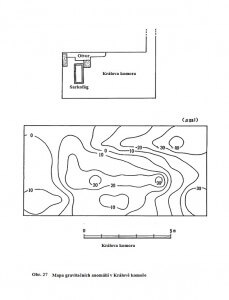 Figure 27 shows the map of residual anomalies. The main positive anomaly is in the center of the room. The result of the electromagnetic survey shows that the abnormal reflection under the floor is in the southwest corner and the northeast corner. The result of this electromagnetic survey agrees with the gravitational survey in the second part of the Japanese scientists' research. But the electromagnetic survey does not show an abnormal reflection in the southeast corner.
Figure 27 shows the map of residual anomalies. The main positive anomaly is in the center of the room. The result of the electromagnetic survey shows that the abnormal reflection under the floor is in the southwest corner and the northeast corner. The result of this electromagnetic survey agrees with the gravitational survey in the second part of the Japanese scientists' research. But the electromagnetic survey does not show an abnormal reflection in the southeast corner.
B) Results in the horizontal corridor
This area was explored by the French team.
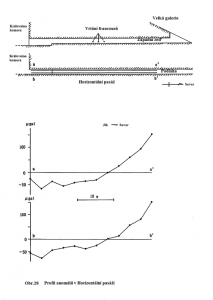 The figure shows the results of the residual anomaly profile. Towards the entrance to the horizontal passage a positive zone is visible, while strong negative properties are visible towards the queen's chamber. Quantitative analysis is very difficult because data is only available along two closely spaced profiles. The results of this survey coincide with observations from the French team. But the value of the positive anomalies of this result is greater than that of the French observation.
The figure shows the results of the residual anomaly profile. Towards the entrance to the horizontal passage a positive zone is visible, while strong negative properties are visible towards the queen's chamber. Quantitative analysis is very difficult because data is only available along two closely spaced profiles. The results of this survey coincide with observations from the French team. But the value of the positive anomalies of this result is greater than that of the French observation.
C) Results around the Great Sphinx
First, gravity measurements were performed in the front of the Great Sphinx (Figures 29 and 30.).
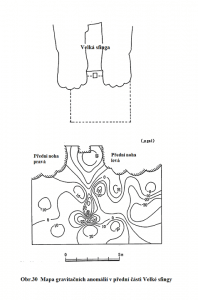 The main two negative anomalies are located on the northern side and in the middle of the area under investigation. Two positive anomalies are located on the eastern and western sides. In addition, the survey was conducted in the northern part of the Great Sphinx.
The main two negative anomalies are located on the northern side and in the middle of the area under investigation. Two positive anomalies are located on the eastern and western sides. In addition, the survey was conducted in the northern part of the Great Sphinx.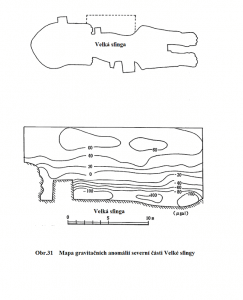 Figure No. 31 shows the area of investigation and measurement result. Major large, negative anomalies are located in a long and narrow space beside the Great Sphinx.
Figure No. 31 shows the area of investigation and measurement result. Major large, negative anomalies are located in a long and narrow space beside the Great Sphinx.
A third gravitational survey was conducted in the southern part of the Great Sphinx. The results and the survey area are shown in Figure 32.
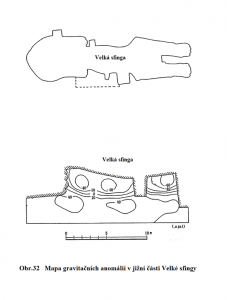 Negative anomalies are also found in the long and narrow space next to the fuselage.
Negative anomalies are also found in the long and narrow space next to the fuselage.
The fourth research was performed alongside the left foreleg of the Great Sphinx.
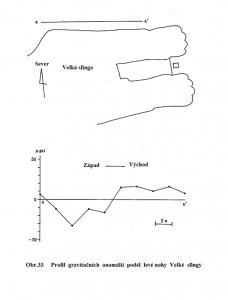 Figure # 33 shows the result and the measurement line. Positive anomalies are located on the eastern and negative anomalies on the western part of the line. The position of the negative anomaly coincides with that where a strong reflection was obtained by the electromagnetic method.
Figure # 33 shows the result and the measurement line. Positive anomalies are located on the eastern and negative anomalies on the western part of the line. The position of the negative anomaly coincides with that where a strong reflection was obtained by the electromagnetic method.
Interpretation of non-destructive research results
A) Inside the Great Pyramid
① The Royal Chamber (third burial chamber)
The floor and wall of the Royal Chambers were investigated using the electromagnetic waves system when the first pyramid survey was conducted. At that time, however, no unusual reflections were observed. In this survey, the floor was re-examined using an 80 MHz antenna along the measuring network installed on the floor, as shown in Figure 34.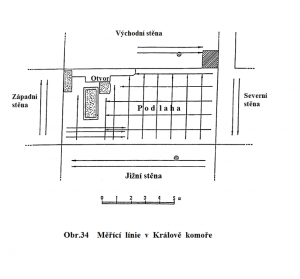 In the southern part of the complex, under the floor of a granite sarcophagus, there is a strong reflection. This indicates the existence of a cavity that was not detected in the previous survey. To determine the extent of the cavity, further analysis is needed to clarify the relationship between the cavity and the tunnel, the opening of which is located on the north floor of the King's Chamber, and which was discovered by Vys.
In the southern part of the complex, under the floor of a granite sarcophagus, there is a strong reflection. This indicates the existence of a cavity that was not detected in the previous survey. To determine the extent of the cavity, further analysis is needed to clarify the relationship between the cavity and the tunnel, the opening of which is located on the north floor of the King's Chamber, and which was discovered by Vys.
As a result of gravity measurement with a microgravimetry, an area with an anomaly was observed in the southeast corner of the Royal Chamber. However, this anomaly was not detected by the electromagnetic wave system.
② Royal chamber - hall
During this survey, the floor and the walls of the hall were examined using the electromagnetic wave reflection method. The reflected waves showed two cavities on the bottom, inside the western wall. Gravity measurement, with a microgravimeter, also showed an anomaly. It is necessary to clarify the relationship between these results and the tunnel with a hole in its western wall.
③ Great gallery
Walls The large galleries were investigated using the electromagnetic field reflection system. Due to the unfavorable state of the surface, the electromagnetic field was disturbed. It was therefore difficult to read the image from the monitor in place. We are currently waiting for the computer to complete the analysis.
④ Queen Chamber (Second Funeral Chamber)
In this survey, we re-examined the four walls by electromagnetic field reflection. Particular attention was paid to the northern wall, where abnormal reflections were observed in the first survey.
The measuring lines shown in Figure 36 were installed on the eastern, western, southern and northern wall surveys. Waves caused by a cavity-like reflection were observed in the western part of the north wall, as was already found in the first survey. As shown in Figure 36, the horizontal and vertical measuring lines were installed in particular on the northern wall. As a result, as in the first survey, the reflection of the other side of the block surface was detected by 3 m behind the northern wall. The monitored image shows the 3 m cavity broad. It has been demonstrated by examining the reflection of a known cavity in the Great Pyramid that the image being viewed is twice as large as the actual dimension.
With this in mind, we must take into account the actual cavity width on the northern side of the northern wall. We decided that its width may range from 1 to 1,5 m. The reflection, suggesting the cavity, was noticed less than 1m from the floor. This is considered to be the true height of the cavity. For this reason, the size of the east-west section is a cavity of approximately 1,5 m to 1 m, which is almost the same as the size of the horizontal passage.
⑤ Horizontal passage
In this survey, the floor and both walls of the horizontal passage were examined using an electromagnetic wave reflection system, and gravity was measured using a microgravimeter. The possibility of determining the shape of the northern cavity in the northern wall, which was found in the western part of the northern wall of the Queen's Chamber, and also examining the western wall by the horizontal passage by electromagnetic method, were considered a critical part of the survey this season.
The Horizontal Passage Test with electromagnetic wave was performed along with the measurement lines shown in Fig. 37.
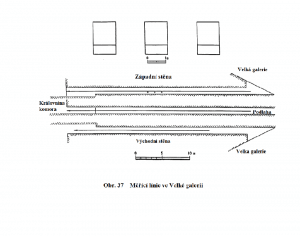 The reflection was observed in the range of about 30 m north of the northern wall of the Queen's chamber. Judging from the fact that two parallel lines of strong reflection were observed with a length of 30 m, it is assumed that the cavity between the walls is a passage, rather than a chamber.
The reflection was observed in the range of about 30 m north of the northern wall of the Queen's chamber. Judging from the fact that two parallel lines of strong reflection were observed with a length of 30 m, it is assumed that the cavity between the walls is a passage, rather than a chamber.
It is assumed that another passage that is parallel to the Horizontal Passage exists behind its western wall. This newly discovered passage begins at a point just one block of latitude outside the north face of the Queen's Chamber. The reflection ends at a point approximately 30 m north of the Queen's Chamber. Therefore, there is an idea that the passage here is facing its end, or turning west at right angles. At present, this, in this case, could not be determined by research using electromagnetic waves.
Further research into the mode of transmission, using enhanced detection devices, will be carried out in the future.
Following the first survey, the floor of the horizontal passage was examined by the method of reflection of electromagnetic waves. The frequency was 80 MHz. In a previous survey, a cavity was found 1,5 m below the floor. It extends about 3 m north of this place, about 15 m north of the Queen's Chamber, where the French mission conducted research by drilling. The results of the survey, by the French mission, were confirmed using an absolute gravimeter. It was confirmed that the cavity widened 2,5 to 3 m downwards and that sand was present in it. This season, our research also showed that there was no cavity north of the large hole where the French mission was drilling. It was confirmed that the cavity exists around the 2nd and 3rd holes from the north. However, in the area south of the holes, the existence of the cavity has not been confirmed. The existence of sand in the cavity was reconfirmed by an 80 MHz antenna. In this survey, the east wall of the horizontal passage was also examined by an electromagnetic reflection system, but no unusual reflections were observed behind the wall.
The cavity discovered by the French mission is expanding westwards. In order to confirm this, the investigation was carried out by inclining the antenna at the angles 30 st., 45 st., And 60 st. under the western wall.
Since it is difficult to draw a conclusion from the monitored image, due to the strong reflection of the surface at the site of the wall and floor connection, interpretation of the results can not be performed until computer analysis has been completed.
⑥ Underground chamber (first burial chamber)
In this survey, the underground chamber was first examined using the method of reflecting electromagnetic waves.
As shown in Figure 39, the measuring lines were installed on the floor of the western part where the surface condition is relatively
favorable, and on the southern, northern, and western walls. The reflection indicates a cavity, approximately 2 m wide and 2 m high, which was observed approximately 3 m inside the western part of the northern wall. In this direction, there is a cave junction that extends from the Great Gallery and the descending passage. However, it is not appropriate to attribute the reflection of the intersection. There is the possibility of another cavity. Currently, whether this cavity is artificial or natural is not known.
⑦ Between the northern entrance and the north wall of the Great Gallery
The area between the northern entrance and the northern wall of the Great Gallery was examined for the first time in this survey using the transfer method. According to the hypothesis of the French mission, there is a hidden corridor in this position, which leads directly from the northern entrance to the Great Gallery. The distance is approximately 50 m. If there was a corridor and hollow space as speculated, the 80 MHz electromagnetic waves used in this survey went through.
We set antennas for receivers and transmitters, near the spanning stone at the northern entrance, and on the northern wall of the Great Gallery, respectively. The survey was carried out at 7 points (Figure No. 40).
However, there was no penetration of electromagnetic waves in any location. Even though we chose the measuring points, they did not have to be placed at either end of the passage - the French team speculated. The research was conducted from seven measurement sites that are considered sufficient to cover almost all areas where the alleged passage is believed to exist. Therefore, electromagnetic waves were transmitted at the 30 st. Yet, the results of this survey were rather negative in terms of the existence of the passage speculated by the French team. Since this survey was the first survey using the transfer method, we would like to avoid making hasty conclusions. We will detect and confirm this result in a further survey using more advanced devices.
⑧ Between the floor of the Royal Chamber and the ceiling of the Queen's Chamber.
The space between the floor of the King's Chamber and the ceiling of the Queen's Chamber was examined by the method of transmission of electromagnetic waves (Fig. 40). The distance is approximately 20 m. As it was confirmed in Japan that the 80 MHz electromagnetic wave was able to penetrate at least 20 m, the wave was expected to penetrate this distance. In reality, however, the wool weakened and barely passed, probably because the stones contained ionized salts, which was caused by the high humidity produced by tourist exhalations and groundwater, which affected the stones by capillary phenomena. As a result, no visible data was obtained.
B) Outside the Great Pyramid
① Second Cheops ship
The first survey, by the electromagnetic wave reflection method, was carried out on limestone lids, which were located in a pit where the second Cheops ship was supposed to be deposited. At that time a possible cavity under the lids was observed, with an average width of 1,7 m. Judging by the irregular reflection observed at depths of 3 m or less, the existence of many kinds of materials in this lower part of the space was highly possible. A similar result was obtained in this survey, in which electromagnetic wave was used
frequency 80 MHz. After that, a survey carried out by the US mission in October of that year revealed the buildup of wooden material for the ship. This proves the accuracy of the electromagnetic wave survey.
② The south side of the Great Pyramid
In the first research, electromagnetic wave reflection was performed in the area south of the Great Pyramid (Figure 41).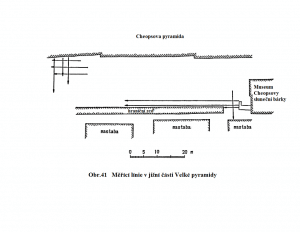 The reflection that indicated the cavity was observed in the western part of the investigated area. The cavity seemed to represent a pit that was approximately 3 m wide, 2 m long, and 3 to 5 m deep. In this survey, the measuring line crossed as shown in Figure 41 and the investigation was performed using electromagnetic wave about the frequency of 80 MHz. The existence of the pit was confirmed.
The reflection that indicated the cavity was observed in the western part of the investigated area. The cavity seemed to represent a pit that was approximately 3 m wide, 2 m long, and 3 to 5 m deep. In this survey, the measuring line crossed as shown in Figure 41 and the investigation was performed using electromagnetic wave about the frequency of 80 MHz. The existence of the pit was confirmed.
C) Area around the Great Sphinx
① Area north of the Great Sphinch
In the first survey, a reflection indicating a cavity was observed by a reflection method with a wave strength of 150 MHz. A similar cavity was recognized on the southern part of the body. As a result, there has been speculation of the existence of a tunnel under the sphinx's body, from north to south. In this survey, at the same place, an investigation was carried out using 80 MHz electromagnetic waves. The same reflection was observed again. It is assumed that the existence of the cavity will be confirmed in the future, after cleaning. In addition, a strong reflection was observed at this point, dividing the front of the body into eastern and western parts, which indicated the possibility of a gap between the limestone, below the base of the rock.
② Area north of the left foot of the Great Sphinx
During the first survey, an electromagnetic survey was conducted in this area. A strong reflection, which spread about 7 m from east to west and about 15 m from north to south, was recorded at a depth of about 1,5 m. From this reflection, the existence of something other than limestone was assumed. In this survey, a measuring line was installed and an 80 MHz electromagnetic wave was used. In the right part there is an area where the reflection was especially strong. The results obtained in this survey were therefore the same as in the previous one.
③ Front Courtyard of the Great Sphinx
The front courtyard of the Great Sphinx forms the base where limestone blocks are artificially arranged. In the first electromagnetic wave survey, a relatively strong reflection was observed at depth 1,5 m under the front courtyard. The site is in the extended axis of the Great Sphinx and indicates the possibility of a cavity. In this survey, the reflection method was adopted using the 80 MHz electromagnetic wave. The measuring lines were located from east to west. The reflection was not significant compared to that obtained in the previous survey. It was found that the existence of the cavity could not be confirmed without drilling.
④ Between the big sphinx paws
In the first survey, the area between the paws of the Great Sphinx was examined by the electromagnetic method of wave reflection. At that time, although the irregular reflection was intense and the measurement was not accurate enough, it was assumed that the cavity existed 1 or 2 m underground and the possibility of a relationship with the cavity, below the front courtyard, was also considered. In this survey, a reflection different from the previous survey was obtained when an 80 MHz electromagnetic wave was used. Therefore, the survey should be performed again with a different frequency. We do computer analyzes of the results of this survey, and the difference between the results of this survey and the previous one, using 150 MHz electromagnetic waves.
⑤ Western Grand Sphinx Terrace
This area was not dug. This is rare around the Great Sphinx. In this survey, the underground was examined using electromagnetic waves, the method of reflection from the surface.
As shown in Fig. 44, eight measuring lines were installed from east to west and 10 from north to south. The area covered in this way was approximately 50 square meters in size. On the eastern side, a bedrock was found near the earth's surface. On the west side, in the bedrock, it was drilled quite deep inside. It is clear from this investigation that various residues remain below the surface of the desert. The walls of Thutmose IV, the remains of the walls that Baraize built to prevent landslides during excavations, and many other structures, appear to be left underground. We will do an excavation in this area, to reveal the conditions underground, and at the same time compare the results of electromagnetic waves investigation and actual excavations.
The contribution of a non-destructive inquiry into the history of Giza
In surveys to date, the possibility of an unknown space, such as a new passage in the north of the Queen's Chamber, has been discovered using scientific methods. Although the presence of such cavities within the Great Pyramid and their recognition by the cavity has been discussed, it has been difficult to validate the hypothesis scientifically. Therefore, these options have not been widely accepted as a scientific and historical opinion. However, it is now possible to estimate the location and extent of these spaces on the basis of scientific methods. From now on, there should be a discussion about this issue.
For the Cheops Pyramid and other pyramids, the presence of these unknown cavities should be taken into account. Afterwards, common theories to interpret the pyramids in Egypt will have to be corrected. Many religious buildings in ancient Egypt have symmetrical structures. If we look at the Queen's Chamber, a passage that is speculated to continue from the north side of the Queen's Chamber, the previous survey and this survey assumes its symmetrical location, with respect to the already existing passage coming from the Queen's Chamber. This structure can be explained later, based on the symbolism of the Great Pyramid, which is discussed in the assessment of architectural history.
The first and second studies revealed that hitherto unknown cavities exist around the Great Sphinx, and that the structures are more complex than usually thought. Due to the fact that the Great Sphinx was built by excavating a bedrock, it is difficult to determine the reign of a particular king in which it was built. By conducting further research in a place where a strong reflection has been observed and in unknown peripheral places, the possibility of finding the key to determine its age will be discovered. Surveys have also been clarified that there were excavations on the south side of the Great Sphinx, through research conducted on the west terrace. Excavations in this area will also provide an indication of its age.